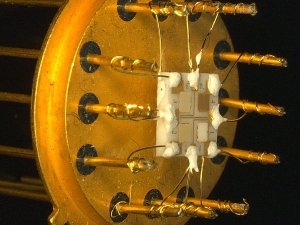Fires are frequently caused by smoldering cables. Novel sensors now help detect such smoldering fires at an early stage by analyzing the plastic vapors released by overheated insulating cables. Scientists of KIT and Karlsruhe University of Applied Sciences have developed these hybrid sensors that combine measurement processes with data evaluation. Their work is reported in the current issue of the Sensors & Transducers Journal.
A smoldering cable can be detected with a little luck before it starts burning: The plastic coating changes color, there is a smell of burning. Hybrid sensors might detect the risk of cable fires earlier, even before they are perceived by eyes and nose. They detect the gases released from the plastic coating due to heating and reliably identify and analyze the gas mixture and its concentration.
In addition, they can also detect interfering gases, such as propene or carbon monoxide, and, hence, exclude false alarms. To this end, the hybrid sensors do not only possess a gas-detecting sensor chip, but also the computation capacity and algorithms needed for evaluating measured data. “The combination of a smart evaluation process with physical measurement is the basic idea of this development,” Dr. Hubert Keller, Simulation and Measurement Project Head of KIT’s Institute for Applied Computer Science, explains.
The highly sensitive and very reliable hybrid sensors might increase safety in cable ducts. In addition, their capability of finding gas mixtures and determining individual gas concentrations might be useful for detecting toxic mold gases during food control, explosive gases in fertilizer silos, or leaks of natural gas pipelines. “Hybrid sensors can be used anywhere as separate systems or in a network. They may also be combined with classical safety technology, such as infrared cameras,” Keller says.
“For the development of the sensor, we use the effect that various gases react in different ways with gas-sensitive metal oxides as a function of temperature,” Professor Dr. Heinz Kohler of the Institute of Sensor Technology and Information Systems (ISIS) of the Karlsruhe University of Applied Sciences says. “This effect is the basis of a self-heated, temperature-controlled sensor chip with four sensors, i.e. a sensor array. “The sensor array is heated cyclically and cooled down again. Simultaneous measurement of electric resistance or conductance yields four specific conductance signatures, the evaluation of which provides information on the composition and concentration of the gas. The current issue of the Sensors & Transducers Journal reports this development in the area of hybrid sensor technology.
Combination of sensor technology and analysis method was funded with EUR 1.3 million for a duration of three years under the hybrid sensor platform project. The project team consisted of computer scientists and mathematicians of KIT, Karlsruhe University of Applied Sciences, and two industry partners. The process has already attracted worldwide attention and won a best paper award for excellent research contributions at two international conferences.
Rolf Seifert, Hubert B. Keller, Navas Illyaskutty, Jens Knoblauch, Heinz Kohler: Numerical Signal Analysis of Thermo-Cyclically Operated MOG Gas Sensor Arrays for Early Identification of Emissions from Overloaded Electric Cables. Sensors & Transducers Journal, Vol. 193, Issue 10, October 2015.
http://www.sensorsportal.com/HTML/DIGEST/P_2738.htm
In close partnership with society, KIT develops solutions for urgent challenges – from climate change, energy transition and sustainable use of natural resources to artificial intelligence, sovereignty and an aging population. As The University in the Helmholtz Association, KIT unites scientific excellence from insight to application-driven research under one roof – and is thus in a unique position to drive this transformation. As a University of Excellence, KIT offers its more than 10,000 employees and 22,800 students outstanding opportunities to shape a sustainable and resilient future. KIT – Science for Impact.

